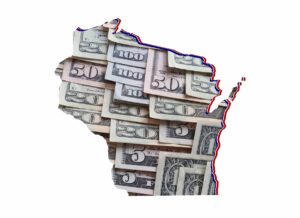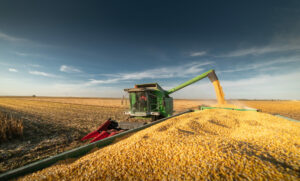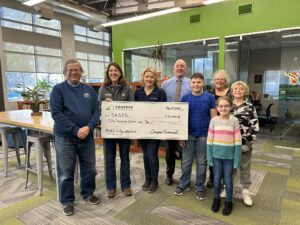Easy On The Salt
Winter Salt Awareness Week is Jan. 22-26. The Wisconsin DNR and Wisconsin Salt Wise invite the public to take time to learn more about the impacts of road salt on drinking water and infrastructure.
What The Research Shows
Although salt keeps Wisconsin roads safe during winter, using more salt than needed comes at a price. In Wisconsin and much of the U.S., chlorides from salt are infiltrating lakes, streams, and groundwater. According to Wisconsin Salt Wise, one teaspoon of salt is all it takes to make five gallons of water toxic for freshwater organisms.
The DNR measures chloride levels in Wisconsin rivers over time, monitoring cumulative chloride loading results at 26 of the state’s largest river systems. Recent studies have shown a steep increase in chloride loads. In the early 2000s, the DNR measured about 600,000 tons of chlorides annually. By 2018, that number increased to nearly 800,000 tons per year. Fifty lakes and one stream in Wisconsin have been designated impaired by high salt concentrations.
“All of the 43 long-term trend water quality monitoring sites across Wisconsin are showing increases in chlorides,” said Shannon Haydin, DNR Storm Water Section Manager. “Chlorides persist in the environment forever and cause significant impacts to fish, aquatic life and human health. In Wisconsin, we see evidence of Fresh Water Salinization Syndrome, a condition where our freshwater becomes more like ocean water in terms of saltiness. Now is the time to make a change and reduce salt use when we can.”
These increased chloride loads are partly due to road salting, but chlorides also enter Wisconsin waters because of water softeners and fertilizers. Find out if your softener is salt-wise with this diagnostic tool.
Increased chloride levels, including environmental and economic effects, significantly impact our daily lives. Nationwide, winter salt causes $5 billion in damage to infrastructure each year, causing corrosion on bridges, roads and other infrastructure. Road salt can also impact pets by causing irritated paws or other health concerns if ingested.
Salt Tips For You
- Shovel: Clear walkways and other areas before the snow turns to ice. The more snow removed manually, the less salt you will need and the more effective it will be.
- Scatter: When using salt, scatter it so there is space between the grains. A 12-ounce coffee mug of salt is enough to treat an entire 20-foot driveway or 10 sidewalk squares.
- Switch: Salt won’t work when pavement temperatures drop below 15 degrees. Switch to sand for traction or a different ice melter that works at lower temperatures.
From Fields to Fairgrounds: The World of Tractor Pulling
The National Tractor Pullers Association (NTPA) Wisconsin Chapter offers standalone events and actively participates in fairs.
Tom Berg, Wisconsin regional director for the NTPA shared insights into the association’s event portfolio highlighting a nearly equal focus on standalone events and fairs.
“The allure of fairs lies in the larger crowds we attract. These create an electrifying atmosphere for both participants and spectators,” explains Berg.
With a membership structure on a regional basis, the Wisconsin Chapter ensures that everyone involved is a member. Regional events, drawing participants from three states, showcase the organization’s commitment to fostering a sense of community.
One of the chapter’s crown jewels is the Tomah Super Nationals which draws participants from across the globe. Reflecting on the generational appeal of tractor pulling, Berg noted a growing interest among the younger generation. He says this is driven by a shared passion for high horsepower and also the family-oriented nature of the sport.
The chapter takes pride in the increasing participation of women. He says their involvement underscores the inclusivity and welcoming atmosphere within the association.
“When it comes to the evolution of tractor pulling, the transition from modest horsepower to the current era of thousands of horsepower is what stands out most,” says Berg. “The sport has witnessed advancements, with tractors now being professionally built from the ground up, adding a level of sophistication and increased costs.”
It is a substantial investment to compete in a tractor pull. Machines starting at $200,000 and ongoing maintenance costs highlight the dedication and commitment of participants.
Demographically, the association sees a diverse audience, extending beyond traditional farming circles. A strong presence from construction and city dwellers adds to the versatile and family-friendly appeal of tractor pulling.
“As long as there’s a passion for motorsports, tractor pulling will thrive. Wisconsin is undeniably one of the strongest tractor pulling states in our union,” says Berg.
See Wisconsin’s Economic Report
Margins tightened for agriculture over the past year, but it’s not without opportunity in 2024, Wisconsin Farm Bureau Federation reports.
“It is important for farmers to follow their business plan, use the tools available to them, and protect a profit when they can,” says WFBF Board Member Kevin Krentz. “Even when 2023 was another hard year in dairy, farmers who utilized tools such as Dairy Revenue Protection and Dairy Margin Coverage had a successful year.”
Krentz’s economic outlook is part of the Wisconsin Bankers Association’s compilation of eight sector-specific reports by industry experts. These reports provide an overview of what is in store for Wisconsin’s economy in 2024: https://www.wisbank.com/2024forecast/
He writes: “2023 was an anxious year for farmers. The year started with many geopolitical issues, such as elevating fertilizer prices, continued supply chain disruptions, and trade tensions. While global challenges did not completely subside, domestic issues became more dominant. Inflation, interest rates, and labor costs have become some of the most prevalent concerns of farmers across Wisconsin.
Although inflation has slowed recently, prices are still high for farmers. Some prices are driven by a strong dollar increasing import costs, such as the costs of chemicals and fertilizers. Though fertilizers were cheaper than in 2022, they were still relatively high historically speaking. Much of the increase in domestic costs was driven by labor costs. From parts to supplies, equipment to services, labor costs have increased throughout the supply chain and pushed costs higher for farmers.
Farming is a high-asset, low-margin industry. In 2023, Wisconsin agriculture not only saw higher replacement costs for assets, but interest rates we haven’t experienced in a generation. This has slowed and will continue to slow asset updates and growth as everyone tries to determine how transitory the rate increases are.
As unemployment rates remain historically low, on-farm labor costs have risen in recent years. According to USDA National Agricultural Statistics Services, farm labor rates were up 4–10% in May of 2023 from the year prior. The range is dependent on the area of farm work.
May rolled around, and farmers across the state were busy planting. By mid-May, the rain turned off and some parts of Wisconsin experienced some of the worst drought conditions in more than a generation. Planting in these conditions led to inconsistent germination in fields as seeds waited for water. Parts of Wisconsin went for up to three months with less than an inch of rainfall. This even affected deep-rooted crops, stressing alfalfa and pastures. Yield concerns increased as the growing season continued. But crop genetics have improved dramatically during the last 20 to 30 years, helping make crops much more drought-tolerant than years before. As harvest began, most farmers were surprised by the above-average yields they experienced. The higher-than-expected yields also caught the markets off guard, and commodity prices quickly took a hit.
As we conclude 2023, Wisconsin farmers have many justifiable concerns. In general, farmers are optimists. They are good at finding solutions and are looking forward to another productive year in 2024.”
Farmer-Led Watershed Lunch Jan 31
The 3rd Annual Regional Northwestern Wisconsin Farmer-Led Row Crop Meet-Up will take place January 31 at 10 am in Baldwin. This event is for farmers and agriculturalists to come together with others from neighboring watersheds within their region to discuss new ideas and share practical tips for implementation.
Before lunch, the Northwestern Wisconsin Farmer-Led Councils will be hosting Lance Gunderson, president and co-owner of Regen Ag Lab. He will speak about soil testing and understanding results to fully account for nutrients to maximize net profit by ensuring cost efficiency of inputs. Gunderson has reviewed over 50,000 soil tests and will be working with local farmers to examine their test results.
After lunch provided by Compeer Financial, a panel of local farmers and agronomic researchers will be presenting takeaways from a variety of field trials and research. These include phosphorous stratification research locally, local field trials on nitrogen efficiency, economics of expanded rotations, soybean planting date, and real talk on the performance of cover crops this year.
This is an event put on by farmers for farmers, and all row crop farmers are encouraged to come. Farmers who register are eligible for door prize drawings. Those interested should register for this event by January 26.
Here’s How Wisconsin Did In Crop Production:
In the 2023 Crop Production Summary, the National Agricultural Statistics Service estimates corn for grain production in Wisconsin at 553 million bushels.
Current year production was up 3 percent from the previous year’s 538 million bushels. NASS estimates Wisconsin’s corn for grain yield at 176 bushels per acre. The area harvested for grain was 3.14 million acres, 150,000 acres above 2022.
By comparison, in the U.S., corn for grain production in 2023 was at a record high 15.3 billion bushels, up 12 percent from the 2022 estimate. The average national yield was at a record high 177.3 bushels per acre, 3.9 bushels above the 2022 yield of 173.4 bushels per acre. Area harvested for grain was 86.5 million acres, up 10 percent from the 2022 estimate.
In Wisconsin, corn planted for all purposes in 2023 was 4 million acres.
Corn for silage production was 16.4 million tons, down 16 percent from 2022. The silage yield estimate of 21 tons per acre was down 1.5 tons per acre from 2022. Producers harvested 780,000 acres of corn for silage, down 10 percent from 2022.
Soybean production was 105 million bushels in 2023. This was down 10 percent from last year’s 116 million bushels. The Wisconsin soybean crop yielded 51 bushels per acre in 2023. The harvested acreage of 2.06 million was down 90,000 acres from 2022. Soybean planted acreage, at 2.11 million, was down 50,000 acres from 2022.
By comparison, in the U.S., soybean production in 2023 totaled 4.16 billion bushels, down 2 percent from 2022. The average yield per acre was 50.6 bushels, up 1 bushel from 2022. Harvested area, at 82.4 million acres, was down 4 percent from last year.
Wisconsin potato production for 2023 was 29.4 million cwt, up 12 percent from 2022. Producers averaged 435 cwt per acre, up 9 percent from the 2022 yield. Planted and harvested acres were 68,000 acres and 67,500 acres, respectively.
Hay
All hay production for the state was 2.24 million tons, down 25 percent from the 2.99 million tons produced in 2022. Producers averaged 2.17 tons per acre, down 0.55 tons per acre from 2022. All hay harvested acres were 1.03 million acres, down 70,000 acres from 2022.
Alfalfa and alfalfa mixtures for hay production were 1.73 million tons, down 30 percent from 2022. Producers averaged 2.70 tons per acre, down 0.40 tons per acre from 2022. Harvested acres were down 160,000 from last year, to 640,000 acres. Wisconsin producers seeded 210,000 acres of alfalfa and alfalfa mixtures in 2023, down 19 percent from 2022.
Other hay production was 507,000 tons, down 1 percent from 2022. Producers averaged 1.30 tons per acre, down 0.40 tons from the 2022 yield. Harvested acres of other hay, at 390,000, were up 90,000 acres from 2022.
Wisconsin Maintains Grain Storage Capacity
Wisconsin’s on-farm storage capacity on Dec. 1 was 380 million bushels. That number hasn’t changed since December 2022, according to the latest grain stocks report from the National Agricultural Statistics Service.
Wisconsin’s 310 off-farm storage facilities had a capacity of 405 million bushels, unchanged from the previous year. As of Dec. 1, Wisconsin had a total of 785 million bushels of storage capacity.
On-farm capacity includes all bins, cribs, sheds, and other structures on farms that normally store whole grains, oilseeds, or pulse crops.
Off-farm capacity included all elevators, warehouses, terminals, merchant mills, other storage, and oilseed crushers, which store whole grains, soybeans, canola, flaxseed, mustard seed, safflower, sunflower, rapeseed, Austrian winter peas, dry edible peas, lentils, and chickpeas/garbanzo beans.
Corn stored in Wisconsin on Dec. 1 totaled 453 million bushels, up 9 percent from December 2022. Of the total stocks, 57 percent were on-farm. The September-November indicated disappearance totaled
173 million bushels, 11 percent below the 195 million bushels from the same quarter the previous year.
Soybeans stored in Wisconsin on Dec. 1 totaled 83 million bushels, down 7 percent from December 2022. Of the total stocks, 33 percent were on-farm. Indicated disappearance for September-November 2023 was 31.5 million bushels, 8 percent below the 34.4 million bushels from the same quarter the previous year.
Farm & Rural Lobby Day This Week
Wisconsin Farmers Union’s annual Farm & Rural Lobby Day is Wednesday. WFU members will advocate for policy priorities set by the grassroots membership at the farm organization’s annual convention.
WFU Policy Coordinator Michelle Ramirez-White tells Mid-West Farm Report about the specific priorities WFU is bringing to Madison:
Policy Priorities
These are a sample of the items that Wisconsin Farmers Union will share with lawmakers during Farm & Rural Lobby Day on Wednesday:
Clean Water
● AB 655/ SB 619: Transition to Grass Pilot Program
Creates a “Transition to Grass Pilot Program” in the Department of Agriculture, Trade and Consumer Protection. This will give support and grants to farmers who are implementing livestock grass-based managed grazing systems. It will also benefit farmers and agribusinesses in the grass-fed livestock business.
Rural Development
● SB 710/AB 750: Payment Processing for Farmers
Provides a $735,000 investment in EBT/credit/debit processing equipment, services, and support for farmers and farmers markets statewide. In turn, this helps increase access to healthy, Wisconsin-grown food, increase sales for our farmers, and broaden the options available for those utilizing EBT benefits.
Dairy
● SB 886: Milk Labeling
Under this bill, no person may label a food product as, or sell or offer for sale a food product that is labeled as, any type of milk unless the food product is cow’s milk or hooved or camelid mammal’s milk or a type of milk that meets certain specifications under federal law.
● SB 431/AB 440: Permit for the Overweight Transportation of Certain Fluid Milk Products
Issues permits to allow the transportation of fluid milk products, including raw milk and milk byproducts, that exceed generally applicable highway weight limitations on Class “A” highways. The bill prohibits DOT from imposing different conditions for different fluid milk products when issuing permits under the bill.
● SB 781: Unpasteurized Dairy
Provides farmers with the ability to sell unpasteurized dairy products through additional channels, accompanied by more robust guidelines and testing requirements compared to any previous proposal authorizing the sale of unpasteurized dairy products in Wisconsin.
Healthcare
● Support SB 717/ AB 746: BadgerCare Public Option
Creates a Basic Health Plan available in the state’s insurance marketplace as established by the Affordable Care Act (ACA), covering individuals earning between 133-200% of the FPL. Establishes a state insurance exchange to give the state the ability to offer special enrollment periods, among other options while still accessing federal premium subsidies.
Nutrition & Education
● SB720/AB754: School Aid
Providing state aid to reimburse public and private schools that provide free meals to all pupils for the costs of those meals and making an appropriation.
● SB712/AB755- Farm to Fork Grants
Allocates $200,000 each year for farm-to-school grants to support the creation and expansion of farm-to-school programs, including:
- promoting production, processing, marketing, and distribution of food produced in Wisconsin for sale to Wisconsin schools
- construction or improvement of facilities for the use of food produced in Wisconsin at Wisconsin schools
- training for food service personnel, farmers, and distributors
- nutritional and agricultural education in the classroom
Nonpartisan Redistricting
WFU encourages the legislature to put partisan politics aside for the court-ordered 2024 redistricting and work together for truly fair, nonpartisan, and constitutional maps. In the future, WFU insists upon the creation of an objective, nonpartisan procedure for the preparation of legislative and congressional redistricting plans.
Lobby Day Details
Farm & Rural Lobby Day will begin at 10 a.m. at Bethel Lutheran Church, 312 Wisconsin Ave., near Capitol Square. Speakers will provide background information on pending legislation that is of interest to farmers and rural residents to help participants prepare for their meetings with legislators.
Following lunch, the group will head to the Capitol to meet with their senators and representatives, with the day’s activities wrapping up around 4 p.m.
There is no cost to participate, and all are welcome to attend. Those interested in attending should pre-register as soon as possible so legislative visits can be planned accordingly: https://www.wisconsinfarmersunion.com/events
Lauer Looks Back On 30 Years
When Joe Lauer visited the College of Agriculture and Life Sciences on the UW-Madison some 30 years ago, he actually had relatively little experience in corn! Lauer came to Wisconsin from the University of Wyoming where he worked nine years on literally every type of crop(24 total) – except corn! That’s one of the insights he shared with Pam Jahnke during a studio conversation recapping his career. On December 31, 2023, Lauer officially retired as the UW-Extension Corn Specialist.
“I really came to UW-Madison for the position, and especially the UW-Extension system we had at the time,” Lauer said. He said that the opportunity to be out interacting with growers, and creating his own network of field research, was very attractive. The timing wasn’t necessarily great though. “Farmers were really struggling weather-wise and economically,” he recalls. Wisconsin had been experienced the 1988-89 drought, and the cool-wet years of 1992-93 (Father’s day frost). Most farms were just trying to recover financially from very difficult times in the 80’s. He said this was also the time when the state started to experience what he called the “demise of the red dairy barn and the rise of the grain bins”. What Lauer means is that many Wisconsin farms were transitioning out of dairying into cash cropping, while some existing dairies were expanding.
Wisconsin’s corn production wasn’t exactly catching national attention either! The state’s battle with weather meant that it had a yield record of 119 bu/A set in 1991. During his first year on the job, growers set a new record of 141 bushel to the acre! That was 18% above the previous record! “I thought ‘man this might be kinda easy’, but it hasn’t worked that way! There’s been a lot of challenges, a lot of them are weather because we’re on the northern edge of the corn belt and weather influences Wisconsin production a lot.”
Lauer’s also very proud of the progress he’s witnessed within the Wisconsin Corn Growers Association. He said when he first started working with the group, they had very little money to hire staff or really implement many programs. He compliments the group for focusing their attention, getting a little more checkoff money, and hiring the right people to ‘shepherd’ the organization forward getting the most ‘bang for their buck’. He said today Wisconsin Corn Growers Association isn’t just a force within the state, but also a national leader.
Lauer said he will continue to honor some speaking engagements he’s made, and he plans to stay in the Madison area. Near term focus will be family. Lauer and his wife, Kathy, have five kids and a growing number of grandchildren to welcome! What’s the one thing most people don’t know about Joe Lauer – you’ll have to listen to the end.
Congratulations Dr. Joe Lauer!
This Week On The Dairy Signal
This week’s episodes of The Dairy Signal® from Professional Dairy Producers® (PDPW) will feature interactive conversations on timely topics for today’s dairy farmers. Tune in on Tuesday for options for on-farm energy generation and storage. Wednesday’s episode will take a deep dive into the latest research on when to breed heifers, and Thursday’s discussion will prepare producers for the dairy industry and market news that will impact their operations in 2024.
Here’s a little more:
Tuesday, Jan.16
Farmers depend on reliable, continuous power to run their business. The next episode in The Path to Smarter Energy series features a discussion on options for on-farm energy generation and storage. Episode presenters will be:
- Mark Inkrott, Co-Founder and Partner, UpField Group,
- Jacob Feutz, Vice President, Renewable Fuels, EnTech Solutions
Wednesday, Jan. 17
Weight vs. Wait? Tune in to learn about the latest research and discussion between weight vs. waiting to breed heifers and the potential outcomes for animal health, performance and a producer’s bottom line. Episode presenters will be:
- Dr. Paul Fricke, PhD, Dairy Reproduction Specialist, University of Wisconsin-Madison
- Megan Lauber, M.S., Ph.D. Candidate, Dairy Reproductive Physiology, Department of Animal & Dairy Sciences, UW-Madison
Thursday, Jan. 18
As we begin the new year, what should dairy producers be thinking about or watching for to help manage through these volatile times? Join in for an update and outlook on dairy industry news and markets. Episode presenter will be:
- Leonard Polzin, Dairy Markets and Policy Outreach Specialist, UW-Extension
Compeer Gives To SAGES
Compeer Financial’s Fund for Rural America awards $50,000 to the School for Agricultural and Environmental Studies. SAGES will use the dollars to expand their agriculture-based research plots and school gardens, and add food animals.
This grant supports innovative programs that encompass four qualities:
- Mission: Aligns with Compeer Financial’s mission, enriching agriculture and rural communities
- Opportunity: Provides a new opportunity, fills a known void in agricultural and rural markets and is an innovative project
- Replication: Can be replicated by others to serve different geographic areas, fostering future collaboration
- Evolution: Evolves over time to create a better future for agriculture and rural America
SAGES, located in Fox Lake, is a public charter school that partners with the Waupun Area School District. The 4K through sixth grade school has implemented a multi-phase program for agricultural education. It’s titled “Growing, Raising and Enriching our Future.”
The school will use the funds for research plots, implementing food animals, expanding school gardens, creating grade-specific agricultural businesses and procuring supplies. The grant enables the school to continue its vision for agricultural education programs. Agriculture classes are part of the curriculum at all grade levels.
“The future agricultural career opportunities are endless,” says Kim Pokorny, agriculture science teacher at SAGES. “From farming to finance to agronomy to technology to food service and everything in between, we need to prepare the next generation of agricultural leaders and consumers. By providing exposure, hands-on learning opportunities and experiences, students can build upon their agricultural interests at the elementary school level. That is exactly what we are doing at SAGES.”
Team members at Compeer refer organizations in their community to apply for the MORE for Ag Grant. Since 2019, Compeer has given nearly $1 million to 23 organizations.











